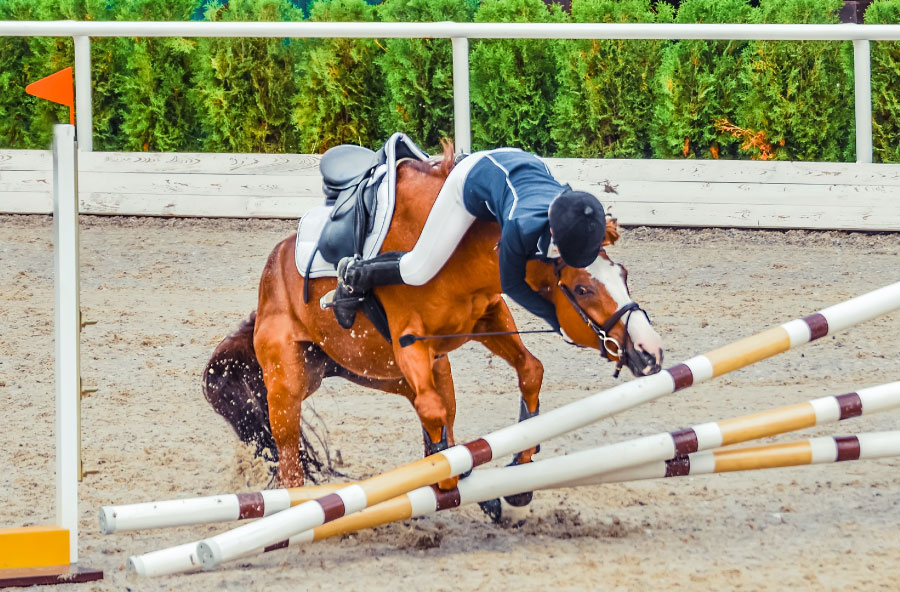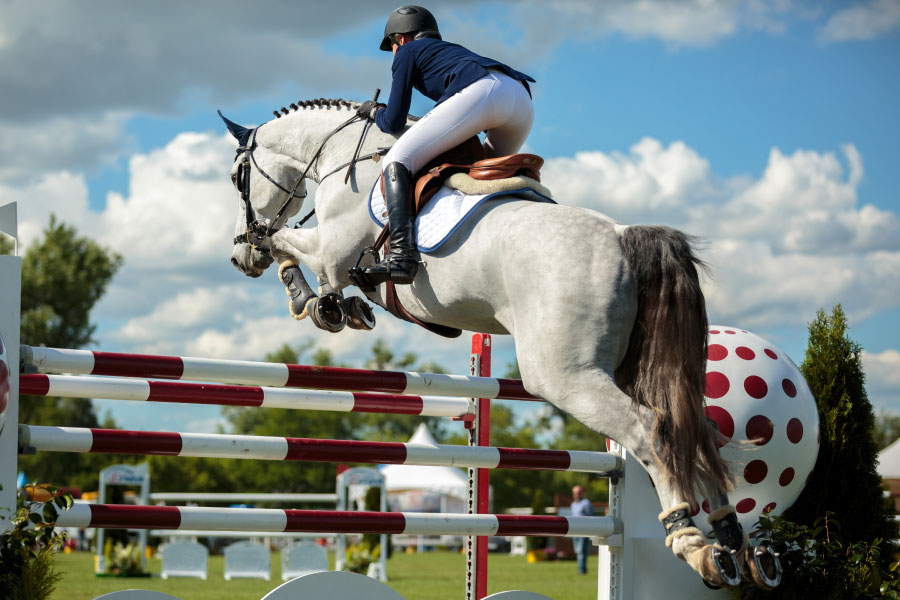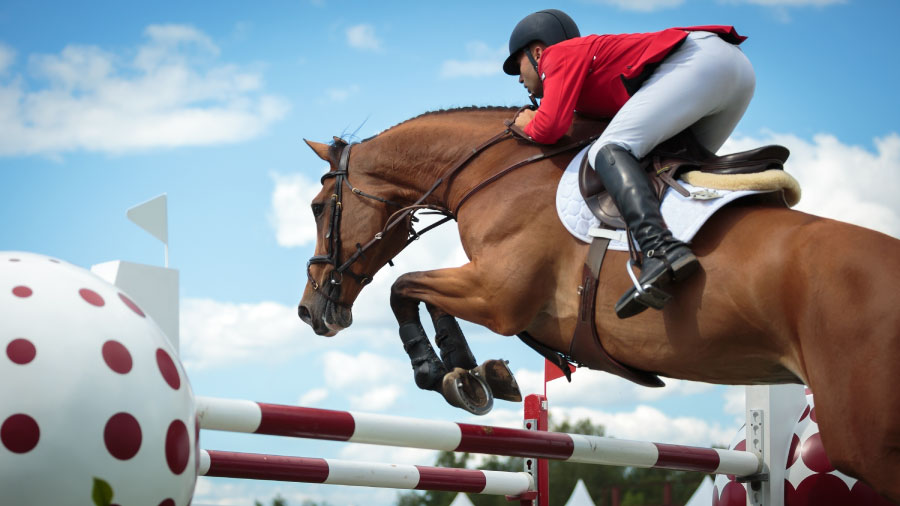- Your source for stall mats, rubber arena footing, arena harrows and arena dust control.

Showjumping has many dangers, but are there ways to prevent them? Every sport has its risks, and showjumping is no different. Showjumping is one of the more dangerous equestrian sport out there. This is especially true for horse and rider combinations competing at the top levels.
Falling is part of the sport, and even experienced riders and trainers have from time to time. For the most part, falling off looks worse then what it feels, and most of the time, we do not get severely injured when falling off our horses, but there is always that chance that we could be.
To be a showjumper, you must love it. Why else would we want to climb on a powerful 600kg animal with a mind of its own and run them over big fences? In this article, we will cover some of the dangers showjumping and what, if anything, you can do to prevent them.
Here are 16 dangers of show jumping and how to prevent them.
In-Experienced Riders
90% of the time, falls happen due to a rider error. It is also true that more experienced riders don’t fall as often. Young or novice riders are less reactive and cannot predict or feel what a horse will do or how they will react. Professional riders are much stronger and secure in the saddle, making them more likely to stay on the horse. When it comes to showjumping, the more experienced you are, the more accurate you can ride over the fences, making it easier for the horse to jump.
How to prevent this: Invest in proper training and build up as much knowledge as you can. It’s good to push yourself but not pass your capabilities. Advocate for yourself and your horse, and don’t let a trainer progress you or your horse too quickly, as this will only create more dangerous situations and exposure to risk.
Foot getting caught in a stirrup
I’m sure a lot of show jumpers have thought about this scenario: Falling off a horse, getting your foot caught in the stirrup, and being dragged around an arena by a galloping, frightened horse that may even kick out at you.
These types of scenarios are not common but do happen, and when they do you can only hope your horse is bombproof, there is someone to help you stop your horse as quickly as possible, or your foot somehow breaks free. If this happens to you, the mental recovery might be harder than recovering physically.
How to prevent this: Safety stirrups are designed with a flexible outer branch or rubber band that will release when a certain amount of pressure is applied. This is not always guaranteed, but they might just save your life. Feel free to check out my complete guide to stirrups here for more on this.
for more on this.
Horse tripping over the jump
This happens when a horse does not clear the jump high enough and ends up tripping over a jump, falling over. This occurs more frequently in cross country where the jumps are solid or nailed on, so they do not fall.
This has happened to me a few times and mostly with young horses learning how to jump. All you can see is the ground coming closer, and there is nothing you can do to stop it but pray that the horses won’t fall on top of you once you hit the ground.
How to prevent this: Make sure that when you are jumping to always use safety cups. Safety cups are specifically designed to reduce incidents of horses falling over jumps. I can honestly say I have not fallen with a horse since switching to safety cups, so they definitely work and should not only be used in competitions but also when training at home.
Horse refusing
There are many reasons why a horse would refuse a jump, and most of the time you can feel the stop coming. It’s the ones that are random and unexpected that can make you go flying off the front, especially when jumping high and going at a forward pace.
Sore or unsound horses will not jump. When your horse is in pain, they probably won’t jump, and one needs to investigate this as a possible reason why your horse could be stopping. If your horse looks sound but doesn’t feel 100% right, then it’s important to advocate for your horse and call it a day.
How to Prevent this: Jump at a height that makes your confidence high and your anxiety low. If your anxiety is too high, then you might be jumping the wrong height. Even going up a grade and jumping a new height should not feel like a 50/50 chance. If your anxiety is high and your confidence low, then you might want to consider moving down a height until you have your, or your horse’s confidence back up.
Another thing you can try is to make sure you always have a strong core and an anchored seat by really pushing your heels down into your stirrups, so you can stay on in case of an unexpected refusal.

Horse ducking out
Again, there are many reasons why this can happen, and we don’t always fall. When your horse keeps ducking out, this can start to make you nervous, especially when you know your horse can sidestep quick enough to throw you off. You also have to worry about falling off and hitting the upright, which is usually quite a solid object to slam into.
How to prevent this: Make sure your horse is confident enough to jump the fence you are asking for. If your horse keeps ducking out, then take it down a few notches and build it up again slowly. In theory, and as mentioned earlier, a horse will not jump when it’s in pain, so make sure the ducking out is not pain-related. As mentioned earlier as well, you can work on anchoring your seat to sit tighter in the saddle.
Falling off mid-air
This can happen when a horse has an awkward jump. For example, when a horse double-takes or jumps you out of the saddle completely, resulting in you falling off over the jump in mid-air.
This has to be one of the worst falls I’ve ever had. I came off mid-air over a 4ft oxer and landed out cold. When I came to, I couldn’t remember where I was or how I got there. My memory came back, but I had a severe concussion and needed much time to recover.
How to prevent this: Make sure you always wear a really good helmet. During training, introduce your horse slowly and at a low height to all the spooky things they may encounter at shows.
Tack breaking
Tack breaking is always such an unnecessary way to fall. You could have a fall from the bridle breaking, leaving you with nothing but your voice and seat to try and stop your horse.
The worst is when a stirrup leather breaks on a landing.
How to Prevent this: Propper and regular cleaning and maintenance of your tack are essential. When you are cleaning your tack, you will have the opportunity to check all the pieces and stitching to make sure everything is still durable and safe to use. If you buy second-hand tack, then you might need to replace your equipment more regularly then when buying new tack.
Slipping
Slipping can happen when the surface or going is too wet, which can cause your horse to slip and lose his balance or even fall. Sometimes a horse can even slip on take-off. Grass arenas are generally more slippery to ride in, and horses that are barefoot can also slip more easily than horses that are shoed.
How to prevent this: When the surface is too wet, it might be a bad idea to make sharp turns and angles. Use studs when riding on grass surfaces, and if your horse is slipping too much when barefoot, then you might need to consider shoeing, even if it’s just on the front feet.
Bucking
Horses bucking and rearing is never fun.
If you have an older horse, make sure this behavior is not stemming from back pain. Sometimes when a horse is not worked regularly, they might be fresh and excited from pent up energy and can throw a few bucks before settling.
When it comes to bucking, a horse can’t get you out of the saddle when you’re not in the saddle, meaning that you don’t want to be sitting down in the saddle, so your horse can sling-shot you across the arena. You want to be standing up in a 2-point position or sitting in a light-seat but not too forward that you can’t keep their heads lifted.
How to prevent this: Make sure you ride your horse regularly so they don’t become dangerously fresh, or lunge them beforehand if you think they might be fresh. You can also talk to your vet if your horse is bucking excessively.
Rearing
Rearing is when a horse stands on his back legs. This is particularly dangerous if a rider reacted by pulling on the reins. When rearing, a horse can fall over backward, injuring themself and/or the rider.
How to prevent this: Find the root of the problem. If it is not pain-related, then your horse might be reacting to your pressure. Rearing should be avoided as far as possible, and if you have a horse that rears, seek a good, experienced trainer to help you fix the problem.

Riding top horses
When you reach the higher levels of show jumping, you will be sitting on a full-blown equestrian athlete that is much stronger than the average trail horse. These animals can become incredibly strong and powerful to jump the required jumps.
In showjumping, unfortunately, a lot of the times, young or inexperienced riders don’t have the financial means to acquire top horses way above their skill level. This is a dangerous combination as a rider will not be able to handle or match the animal underneath them.
How to prevent this: Make sure to keep your horse in a consistent exercise routine, and do not ride horses above your skill level.
Riding young horses
Young horses are unpredictable, and that is why green riders and green horses do not go together. Young horses like to test the waters when it comes to an understanding of what their job is. They are quick to react, so you, as the rider, have to be even faster.
How to prevent this: Rider experience can increase sensitivity and predictability of what a horse might do, or how they might react. Young horses need confident riders to show them the ropes and to gain the horse’s trust.
Riding and training for derby events
Some show jumping events are more dangerous than others. Derby events are not like ordinary show jumping events. Derby competitions involve obstacles that are not normally jumped, thus making them a bit more dangerous than ordinary show jumping competitions.
How to prevent this: make sure you train and introduce your horse slowly to the different types of jumps. If your horse is super spooky with derby, you might want to try jumping a height or two lower than usual to get your horse happily around the track.
New horse and rider combination
When starting with a new horse, a proper partnership must be formed before attempting to compete. Jumping big fences on a horse, you are not familiar with can lead to mistakes and mishaps that can be prevented if you know how your horse will react in uncertain situations and competitive environments.
How to prevent this: Take the time to build a partnership with a new horse, so you know what your horse needs from you when jumping. Know your horse well enough to handle unplanned situations effectively and safely.
Maxed out jumping capabilities
Not all horses are meant to be jumpers, and not all jumpers are top horses. Sometimes you can train and compete with a horse up to a certain level, just to have them consistently say no when the jumps get bigger. When a horse has capped-out, and a rider persists, then the horse can react by stopping, rearing, or ducking-out, among several other things.
How to prevent this: know your horse’s limits. Not all horses have the capabilities to jump the big jumps, and forcing your horse to jump is never a long-term solution. Knowing when to walk away could save you from a few injuries.
The higher the jumps, the higher the risks
The closer a horse and rider combination gets to the top level, the higher the risk for serious accidents. Rider error is less of an issue when the jumps are small because the horse can still easily make the jump and help the rider out. However, rider error at the top level can be disastrous. The higher you jump, the more precise your horse has to be ridden and placed for a jump, leaving little room for error.
Horses are amazing animals, but they will only be able to help you out so many times before saying no and losing their confidence. Most horses will “self-preserve,” and when they feel that they might hurt themselves trying to take off from a jump where a rider has placed them too far or too deep, they probably won’t attempt it, sending the rider flying.
How to prevent this: Make sure you can ride at that level of accuracy required for each level before progressing to the next. Invest in good training and make sure your horse is confident to help you out when needed.

Safety helmets and body protectors
Safety Helmet
Riding and jumping with a helmet is mandatory in all equestrian competitions. Studies have shown that safety helmets have an 80% effectiveness in preventing injury and death. Head injuries cause around 60% or more of horse-related deaths. Investing in a proper ASTM/SEI approved safety helmet can reduce your chances of sustaining a severe head injury.
For a comprehensive guide on exactly what gear you need for showjumping, check out our post “Showjumping Wear: Exactly What To Wear And Why! “
“
Body Protectors
Studies have found that there is no reduction in risk when riding with body protectors while showjumping. The results showed no correlation with a decrease in injury when riders wore protective vests or body protectors when doing flatwork or showjumping.
This does not mean that there are no benefits to show jumpers to wear body protectors. Two main benefits of wearing a body protector in showjumping are:
- It can protect bruised or heeling ribs.
- Protect novice riders and riders that fall more than average.
For more on the use of body protectors in showjumping, check out my article on it here .
.
What can you do to protect yourself while jumping?
- Invest in proper training.
- Always use safety cups.
- Get a good quality safety helmet.
- Check and maintain your tack often
- Be an athlete yourself.
- Advocate for your horse and yourself.
In Conclusion
Don’t put yourself in a situation where you can fall. Yes, show jumping is dangerous, and you can get severely injured, but you can take the necessary precautions and not be reckless to avoid serious injury.

